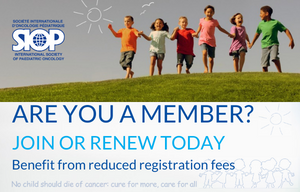Frequently asked questions (FAQs)
1. Who can enter data for the Global Mapping Programme?
We are inviting key hospital personnel and subject matter experts (e.g., directors of paediatric oncology units or medical directors) to enter data or to designate appropriate content experts to contribute. These are clinicians with knowledge of all services being provided to children/adolescents with cancer in your centre.
2. Can SIOP provide assistance to my hospital?
The initial aim is just to map services provided in each country. Then we will determine whether SIOP as an organisation can provide assistance in terms of lobbying or advocacy. Unfortunately, SIOP does not provide financial support to hospitals or institutions.
You are encouraged to become a member of SIOP to join advocacy efforts, learn more about resources that may help you and network. SIOP membership rates have been significantly reduced for people in low- or lower- middle-income countries. Find out more about SIOP Membership – https://siop-online.org/membership/.
3. What type of data are you looking for?
Information on access to facilities, medication, and support services (e.g., pathology, psychosocial, etc.) at your hospital or institution. For example, if you have an MRI scanner at your hospital or institution, but it is never available, or too expensive for paediatric oncology patients, then please answer NO.
4. Where can I find more information about the programme?
If you still have a question, please email info@siop-online.org.
5. How can I get involved?
Please email info@siop-online.org.
6. Where will the data be published?
Reports will be made available on the following websites:
SIOP – https://siop-online.org/
Cancer POINTE – https://cancerpointe.com
Resonance – https://resonancehealth.org/
7. Who are the people behind this?
This data is being collected by and managed by SIOP and cancerPOINTE members.
SIOP is the only global multidisciplinary society entirely devoted to paediatric and adolescent cancer. The society has over 2,500 members worldwide including doctors, nurses, other health-care professionals, scientists and researchers.
Cancer POINTE is the online tool of the Education and Training Working Group of SIOP Paediatric Oncology Developing Countries (PODC).
8. How will this data be used?
We intend to establish the levels of services for children/adolescents with cancer to determine where there are gaps or inequities. Having a clearer picture will make it easier for funders to invest in improving services. We intend to use this data to lobby at a high level (e.g. with the World Health Organisation and government ministries) for increased attention to childhood and adolescent cancer care. We would like to increase SIOP membership in low- and middle-income countries so priorities in these regions are highlighted in SIOP activities.
9. Will this data benefit me?
We hope to provide adapted treatment protocols for use in low- and middle-income countries according to the facilities and resources at your hospital. This should be of direct help to you.
10. How can I use this data?
You may find it useful to network or refer patients outside your centre/country. If you have a patient requiring care unavailable in your country, you may find resources and contacts through SIOP, e.g., for stem cell transplant, targeted therapy, or clinical trials.
Comparison of services in your region may strengthen your argument when lobbying for more comprehensive services in your region or centre. You may also be able to locate potential collaborators for research that is relevant to your region.
11. Where is the map of all hospitals and what does it show?
The map of all hospitals is currently being created not currently available. In the future, it will be displayed on:
SIOP – https://siop-online.org/
Cancer POINTE – https://cancerpointe.com
Resonance – https://resonancehealth.org/
The online map will show the following details:
Name of hospital
Address
Website (if there is one)
Contact details (optional)
12. What does SIOP do?
SIOP’s objectives and goals:
To advocate globally for children with cancer and their families
To focus attention on future research needs in paediatric oncology
To explore possible partnerships with other stakeholders sharing the same mission and vision, and elaborating a common agenda
To increase the SIOP membership to have a vibrant society which acts on needs and ideas of its members
Home
13. Should I forward the link to the survey to my colleagues in other hospitals?
No, we are contacting people directly.
14. Has any data been published yet?
Yes, you can see some initial findings in this published paper:
Pediatric Oncology Clinical Trials and Collaborative Research in Africa: Current Landscape and Future Perspectives
This YouTube video highlights some of our findings from Africa:
SIOP Global Mapping Project – Results from Africa with Dr. Jennifer Geel
The latest information about the SIOP Global Mapping Programme is available here: https://siop-online.org/globalmapping/
15. Can I provide more data than the questions asked on Resonance?
Yes, you will be able to provide more information when the maps are available.
16. What languages will the data be available in?
We will be publishing the data in English.
17. Will this programme include adult cancers?
No, this programme only covers childhood cancers.
18. Will this programme include other childhood diseases or just cancer?
No, this programme will only cover childhood cancers.
19. What is SIOP’s relationship with the World Health Organisation (WHO) and how is that relevant for the programme?
In January 2018, SIOP was formally accepted into official relations status with WHO as a non-state actor. One objective of SIOP’s 3-year WHO work plan is to explore health workforce capacity for childhood cancer. Data from this programme will be used by WHO and other global stakeholders to better understand access to childhood cancer care.
WHO Global Initiative for Childhood Cancer




